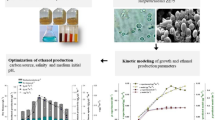Abstract
Ethanol was rapidly degraded to mainly acetate in anaerobic freshwater sediment slurries. Propionate was produced in small amounts. Desulfovibrio species were the dominant bacteria among the ethanol-degrading organisms. The propionate-producing Desulfobulbus propionicus came to the fore under iron-limited conditions in an ethanol-limited chemostat with excess sulfate inoculated with anaerobic intertidal freshwater sediment. In the absence of sulfate, ethanol was fermented by D. propionicus Lindhorst to propionate and acetate in a molar ratio of 2.0.l-Propanol was intermediately produced during the fermentation of ethanol. In the presence of H2 and CO2, ethanol was quantitatively converted to propionate. H2-plus sulfate-grown cells of D. propionicus Lindhorst were able to oxidize l-propanol and l-butanol to propionate and butyrate respectively with the concomitant reduction of acetate plus CO2 to propionate. Growth was also observed on acetate alone in the presence of H2 and CO2 D. propionicus was able to grow mixotrophically on H2 plus an organic compound. Finally, a brief discussion has been given of the ecological niche of D. propionicus in anaerobic freshwater sediments.
Similar content being viewed by others
References
Boone, DR, Bryant MP (1980) Propionate-degrading bacterium, Syntrophobacter wolinii sp. nov. gen nov., from methanogenic encosystems. Appl Environm Microbiol. 40:626–632
Bornstein, BT, Barker, HA (1948) The nutrition of Clostridium kluyveri. J Bacteriol 55:223–230
Bryant MP (1976) The microbiology of anaerobic degradation and methanogenesis with special reference to sewage. In: Schlegel HG, Barnea J (eds) Microbial energy conversion. Erich Goltze KG, Göttingen, pp 107–117
Bryant MP (1979) Microbial methane production — theoretical aspects. J Anim Sci 48:193–201
Bryant MP, Burkey LA (1956) The characteristics of lactate-fermenting sporeforming anaerobes from silage. J Bacteriol 71:43–46
Bryant MP, Campbell, LL, Reddy CA, Crabill MR (1977) Growth of Desulfovibrio in lactate and ethanol media low in sulfate in association with H2-utilizing methanogenic bacteria. Appl Environm Microbiol 33:1162–1169
Bryant MP, Wolin EA, Wolin MJ, Wolfe RS (1967) Methanobacillus omelianskii, a symbiotic association of two species of bacteria. Arch Mikrobiol 59:20–31
Cappenberg ThE, Prins RA (1974) Interrelation between sulfatereducing and methane-producing bacteria in bottom deposits of a freshwater lake. III. Experiments with 14C-labeled substrates. Antonie van Leeuwenhoek, J. Microbiol Serol 40:457–469
Counotte GHM, Prins RA (1979) Regulation of rumen lactate metabolism and the role of lactic acid in nutritional disorders of ruminants. Vet Sci Commun 2:277–303
Holdeman LV, Cato ED, Moore WEC (1977) Anaerobe Laboratory Manual. 4th ed. VPI Anaerobe Laboratory, Virginia Polytechnic Institute and State University, Blacksburg, West Virginia, USA
Hungate RE (1966) The rumen and its microbes. Academic Press, New York
Huser BA, Wuhrmann K, Zehnder AJB (1982) Methanotrix söhngenii gen. nov. sp. nov., a new acetotrophic non-hydrogen-oxidizing methane bacterium. Arch Microbiol 132:1–9
Jørgensen BB (1977) The sulfur cycle of a coastal marine sediment (Limfjorden, Denmark) Limnol Oceanogr. 22:814–832
Kaspar H, Wuhrmann K (1978) Product inhibition in sludge digestion. Microb Ecol 4:241–248
Laanbroek HJ, Pfennig N (1981) Oxidation of short-chain fatty acids by sulfate-reducing bacteria in freshwater and in marine sediments. Arch Microbiol 128:330–335
Laanbroek HJ, Smit AJ, Klein Nulend G, Veldkamp H (1979) Competition for l-glutamate between specialised and versatile Clostridium species. Arch Microbiol 120:61–66
Laanbroek HJ, Veldkamp H (1982) Microbial interactions in sediment communities. Phil Trans R Soc Lond B 297:533–550
Lovley DR, Dwyer DF, Klug MJ (1982) Kinetic analysis of competition between sulfate reducers and methanogens for hydrogen in sediments. Appl Environm Microbiol 43:1373–1379
Lovley DR, Klug MJ (1982) Intermediary metabolism of organic matter in the sediments of a eutrophic lake. Appl Environm Microbiol 43:552–560
Mah RA, Smith MR (1981) The methanogenic bacteria. In: Starr MP, Stolp H, Trüper HG, Balows A, Schlegel HG (eds) The prokaryotes, a handbook on habitats, isolation and identification of bacteria, Springer, Berlin Heidelberg New York, pp. 948–977
McInerney MJ, Bryant MP (1981) Anaerobic degradation of lactate by syntrophic associations of Methanosarcina barkeri, and Desulfovibrio species and effect of H2 on acetate degradation. Appl Environm Microbiol 41:346–354
Mountfort DO, Asher RA (1981) Role of sulfate reduction versus methanogenesis in terminal carbon flow in polluted intertidal sediment of Waimea Inlet, Nelson, New Zealand. Appl Environm Microbiol 42:252–258
Mountfort DO, Asher RA, Mays EL, Tiedje JM (1980) Carbon and electron flow in mud and sandflat intertidal sediments at Delaware Inlet, Nelson, New Zealand. Appl Environm Microbiol 39:686–694
Pfennig N, Widdel F, Trüper HG (1981) The dissimilatory sulfatereducing bacteria. In: Starr MP, Stolp H, Trüper HG, Balows A, Schlegel HG (eds) The prokaryotes, a handbook on habitats, isolation and identification of bacteria. Springer, Berlin Heidelberg New York, pp 928–940
Samain E, Albagnac G, Dubourguier HC, Touzel JP (1982) Characterization of a new propionic acid bacterium that ferments ethanol and displays a growth factor-dependent association with a gram-negative homoacetogen. FEMS Microbiol Lett 15:69–74
Schönheit P, Kristjansson JK, Thauer RK (1982) Kinetic mechanism for the ability of sulfate reducers to outcompete methanogens for acetate. Arch Microbiol 132:285–288
Smith MR, Mah RA (1978) Growth and methanogenesis by Methanosarcina strain 227 on acetate and methanol Appl Environm Microbiol 36:870–879
Sørensen J, Christensen D, Jørgensen BB (1981) Volatile fatty acids and hydrogen as substrates for sulfate-reducing bacteria in anaerobic marine sediment. Appl Environm Microbiol 42:5–11
Widdel F (1980) Anaerober Abbau von Fettsäuren und Benzoesäure durch neu isolierte Arten sulfat-reduzierender Bakterien. Ph D Thesis, Georg-August-Universität Göttingen
Widdel F, Pfennig N (1982) Studies on the dissimilatory sulfate-reducing bacteria that decompose fatty acids. II. Incomplete oxidation of propionate by Desulfobulbus propionicus gen. nov. sp. nov. Arch Microbiol 131:360–365
Winfrey MR, Zeikus JG (1977) Effect of sulfate on carbon and electron flow during methanogenesis in freshwater sediments. Appl Environm Microbiol 33:275–281
Winfrey MR, Zeikus JG (1979) Anaerobic metabolism of immediate methane precursors in lake Mendota. Appl Environm Microbiol 37:244–253
Zehnder AJB, Huser BA, Brock TD, Wuhrmann K (1980) Characterization of an acetate-decarboxylating non-hydrogenoxidizing methane bacterium. Arch Microbiol 124:1–11
Author information
Authors and Affiliations
Rights and permissions
About this article
Cite this article
Laanbroek, H.J., Abee, T. & Voogd, I.L. Alcohol conversion by Desulfobulbus propionicus Lindhorst in the presence and absence of sulfate and hydrogen. Arch. Microbiol. 133, 178–184 (1982). https://doi.org/10.1007/BF00414998
Received:
Accepted:
Issue Date:
DOI: https://doi.org/10.1007/BF00414998




